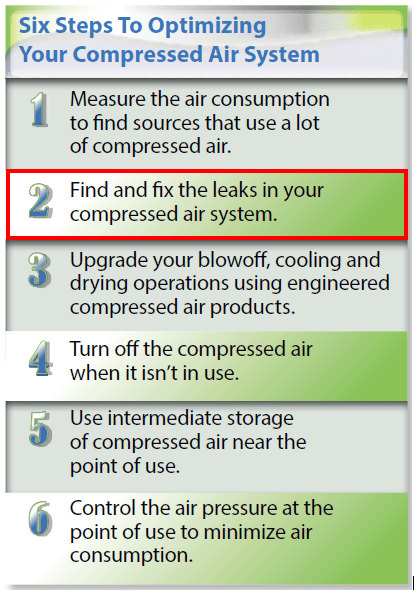Knowing your compressed air needs and understanding the limitations of your equipment is essential when optimizing your compressed air system. Everything about compressed air systems are interrelated. Items putting demand on your system can and will effect how the equipment supplying the demand will operate. Taking a holistic approach when optimizing your compressed air system will not only give you a better understanding of your supply and demand requirements but will also serve as the most efficient means to optimize your process. Now lets look at the six steps to optimizing.

- Measure: the air consumption You must create a baseline to understand your demand requirements. How can you measure your improvements if you do not understand your total demand or baseline? Installing an EXAIR Flow Meter to your main air lines will help identify the amount of compressed air demand you have and help identify areas of concern.
- Find and fix leaks in the system: The repair of compressed air leaks is one of easiest ways to gain energy savings. In most cases all you need is a keen sense of hearing to locate a leak. Once a you have confirmed a leak then the make the necessary repairs. Harder to find leaks may require tools such as EXAIR’s Ultrasonic Leak Detector. This is a hand held high quality instrument that can be used to locate costly air leaks.
- Upgrade your blow off, cooling and drying operations: Updating your compressed air process tooling can save you energy and help you comply with OSHA noise and safety regulations. An example would be to replace old blow off or open pipe systems with EXAIR Safety Air Nozzles. Replacing open copper tubes or pipes can amount up to 80% air savings. You achieve lower sound levels and significant energy savings.
- Turn off the compressed air when it isn’t in use: It sounds obvious but how many times has an operator left for a break or lunch and doesn’t shut off the compressed air for his/her station? The minutes add up to a significant amount of time annually meaning there is opportunity for energy savings. The use of solenoid valves will help but EXAIR’s Electronic Flow Control (EFC) will dramatically reduce compressed air costs with the use of a photoelectric sensor and timing control.
- Use intermediate storage of compressed air near the point of use: The use of storage receivers can improve your overall system efficiency in a number of ways. For example, using a main air receiver at the compressor room can make load/unload compressor control more efficient. Localizing receiver tanks such as EXAIR’s 9500-60 sixty gallon receiver tank by the point of use for a high demand process will stabilize the demand fluctuations allowing a more fluid operation.
- Control the air pressure at the point of use to minimize air consumption: The use of pressure regulators will resolve this issue. Using regulators you can control the amount of air being processed at each point of use. EXAIR offers different sized pressure regulators depending upon your air line and process requirements. Regulating the compressed air to the minimum amount required and will reduce your overall demand resulting in annual savings and a payback schedule.
Compressed air optimization can definitely be implemented using low cost and manual procedures but sometimes you will need a higher level means to achieve your goal. EXAIR has many optimization products to support your efforts. You can review our catalog, blogs and videos at www.EXAIR.com or by calling 800.903.9247 and any of our qualified Application Engineers will assist you.
Eric Kuhnash
Application Engineer
E-mail: EricKuhnash@exair.com
Twitter: Twitter: @EXAIR_EK